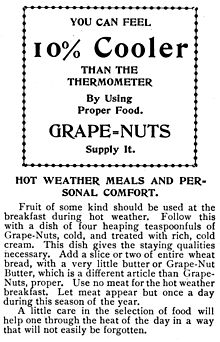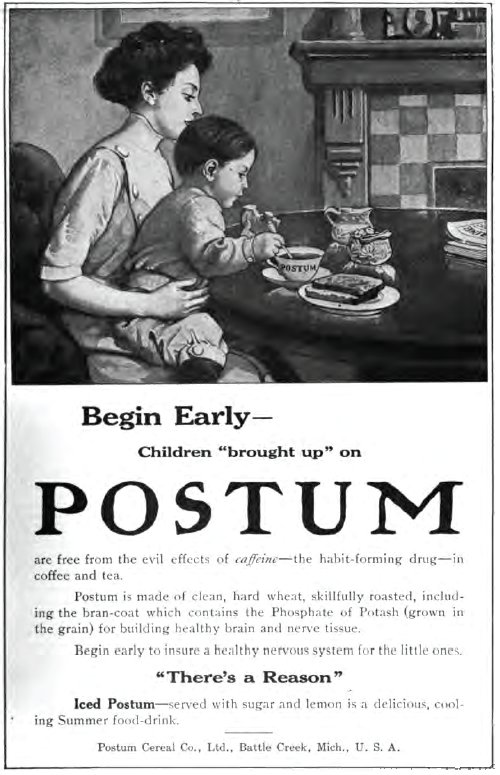Seventies-era Coca-Cola ad.
Tuesday, August 25, 2015
Thursday, August 20, 2015
Perhaps I'm reading too much into this...
But I suspect the Kellogg's Variety Pack was another product of the Baby Boom.
Wednesday, August 19, 2015
Popsicle Pete and friends
Popsicle (now owned by Unilever of all people) was another staple of kids' advertising.
In April 1939, Popsicle Pete was introduced on the radio program Buck Rogers in the 25th Century as having won the "Typical American Boy Contest." The character told listeners that they could win presents by sending wrappers from Popsicle products to the manufacturer. During the 1940s, Popsicle Pete ads were created by Woody Gelman and his partner Ben Solomon. The ads appeared in print, television commercials, and activity books until 1995.
But the real fascination came with those red dots.
Pop culture historian has a more personal take.
That's right: It's the dictionary definition of empty calories — the orange popsicle. I liked the way they looked. I liked the way they tasted. I liked that nothing bad ever happened to you while eating an orange popsicle and I regretted that that time period lasted such a brief time. Sadly, you couldn't draw it out and make the "safe" feeling last because the popsicle would melt at a rapidly-accelerating pace and drip all over you and become more of a problem than a joy. Still, it was great while it lasted.
This feeling, by the way, only applied to orange popsicles. A grape popsicle or a red one was just a hunk of frozen flavored water. I was never sure what the red ones were. I think they were whatever you wanted them to be. If you asked for strawberry, they gave you a red one. If you asked for cherry, they gave you the same red one. Or raspberry. Or one time, even apple. I'm sure that if I'd asked for a tomato popsicle, they would have handed me one of those red ones. It tasted as much like tomato as it did any of those other flavors.
As wonderful as they were, there was another downside to orange popsicles: The two sticks. I could rarely get the one-stick variety in my area. which was silly. Think how many trees they could have saved by only inserting one…but they gave you two on the faulty premise that some folks might want to split the popsicle in half and share it with a friend.
First thing wrong with that concept: Share it with a friend? Never. Let my cheapo friend get his own orange popsicle. Even if you were eight, it wasn't a significant expenditure.
Second problem: Splitting one of those things in half was about as easy as splitting the atom and almost as dangerous. I certainly never successfully accomplished either.
Usually, attempting it would send one entire half of your beloved orange popsicle plunging to the pavement. Or one stick would come out, making the popsicle impossible to share and awkward to eat. In the TV commercials, some trained ninja popsicle-divider would grasp the two sticks, give an artful twist and bisect the popsicle perfectly. They should have put up a little disclaimer: DON'T TRY THIS AT HOME — because it never worked like that in reality.
So you'd just eat the popsicle with two sticks, which would put you perpetually off-balance. Whichever one you held was the wrong one. But I still loved them…up until about the age of twelve or thirteen.
When you're in that age range, much changes in your world. Certain toys you own seem childish and you toss them out as a rite of passage. You have to start seriously thinking about a career or at least a way of start making spending money. If you're a boy, girls suddenly seem a lot less yucchy. And orange popsicles lose a large chunk of their magic.
Tuesday, August 11, 2015
That Seventies Show
I'm not sure if this ad did a good job promoting 7 Up, but it is certainly one hell of a time capsule.
Sunday, August 9, 2015
"Since John Harvey Kellogg gave C.W. Post his first enema"
I generally like Justin Fox, but in this Bloomberg piece, he's working really hard to avoid the obvious conclusion.
“Macronutritious” is a bit of a stretch. Soylent is not all that nutrient dense (make sure to note the calories).
For less than a fourth of those calories, here's what you get with a bowl of black beans.
I'd also recommend adding some nonfat Greek yogurt to your spicy bean soup as a sour cream substitute
Nor do you have to cook to do better than Soylent. I did a quick check at the grocery store last night and I found lots of frozen entrees that gave you more nutrition for less calories than Rosa Lab's product.
Basically, when you cut through all of the pseudo science and buzzwords and LOOKATME antics, Rhinehart is simply peddling a mediocre protein shake with the same tired miracle food claims that marketers have been using since John Harvey Kellogg gave C.W. Post his first enema.
Here's what happens when actual scientists look at these claims:
Fox seems to imply that being "chief executive officer of a corporation with $21.5 million in venture capital funding" undercuts the impression of flakiness, but wouldn't it make more sense to flip that around and ask what the flakiness says about the state of venture capital.
There is no reason to believe that Rob Rhinehart is anything more than a snake oil salesman with a propensity for idiotic babbling or that Soylent is anything more than a crappy protein shake dressed up with bad science and a standard miracle-food spiel. The fact that someone gave this guy a twenty million does not reflect well on the judgement of VC firms, but in their defense, the company that issued that check was Andreessen Horowitz, and no company co-foundedd by Marc Andreessen can be considered representative when it comes to flakiness.
On Monday, software engineer Rob Rhinehart published an account of his new life without alternating electrical current -- which he has undertaken because generating that current "produces 32 percent of all greenhouse gases, more than any other economic sector." Connection to the power grid isn’t all Rhinehart has given up. He also doesn’t drive, wash his clothes (or hire anyone else to wash them) or cook anything but coffee and tea. But he still lives in a big city (Los Angeles) and is chief executive officer of a corporation with $21.5 million in venture capital funding.
That corporation is Rosa Labs, the maker of Soylent, a “macronutritious food beverage” designed to free its buyers from the drudgery of shopping, cooking and chewing. In the 2,900-word post on his personal blog, Rhinehart worked in an extended testimonial for Soylent 2.0, a new, improved version of the drink -- algae and soy seem to be the two most important ingredients -- that will begin shipping in October.
“Macronutritious” is a bit of a stretch. Soylent is not all that nutrient dense (make sure to note the calories).
Nutrition
The following summarizes the nutrition facts and ingredients for Soylent 1.5.[35] The nutrition facts are based on one serving of 115 grams (4.1 oz).[35] Each Soylent pouch contains four servings.
| Serving Size 115g | Servings per Container: 4 | |
| Calories | 500 | |
| Calories from fat | 200 | |
| Amount per Serving | % Daily Value* | |
|---|---|---|
| Total Fat | 23g | 35% |
| Saturated Fat | 2.5g | 13% |
| Trans Fat | 0g | N/A |
| Cholesterol | 0 mg | 0% |
| Sodium | 360 mg | 16% |
| Potassium | 866 mg | 25% |
| Total Carbohydrate | 57g | 19% |
| Dietary Fiber | 3g | 12% |
| Sugars | 15g | |
| Protein | 20g |
For less than a fourth of those calories, here's what you get with a bowl of black beans.
I'd also recommend adding some nonfat Greek yogurt to your spicy bean soup as a sour cream substitute
Nor do you have to cook to do better than Soylent. I did a quick check at the grocery store last night and I found lots of frozen entrees that gave you more nutrition for less calories than Rosa Lab's product.
Basically, when you cut through all of the pseudo science and buzzwords and LOOKATME antics, Rhinehart is simply peddling a mediocre protein shake with the same tired miracle food claims that marketers have been using since John Harvey Kellogg gave C.W. Post his first enema.
Here's what happens when actual scientists look at these claims:
Susan Roberts, Professor at Tufts University's Friedman School of Nutrition Science and Policy, likened Soylent to already available nutritional shakes. While there might be some benefit to Soylent's low saturated fat content, she said, there are certain risks inherent in a non-food diet. "[T]here are so many unknown chemicals in fruits and vegetables that they will not be able to duplicate in a formula exactly," she said in an email. She says that, if Soylent is formulated properly, a person could certainly live on it, but she doubts they would experience optimal health. She fears that in the long-term, a food-free diet could open a person up to chronic health issues.
Tracy Anthony, Associate Professor of Nutritional Sciences at Rutgers University, speaking to us in an email, criticized the formula specifically:
[T]he fast-digesting soluble protein source (whey) in combination with the simple sugar source (maltodextrin) creates a product that is very high glycemic. This product would not promote healthy glucose control, satiety and cognitive well-being with insulin spiking at each point of Soylent consumption.
She also echoed Roberts' sentiment, that ingesting the minimum nutrition required by the human body is not the same thing as maintaining a healthy diet. Could a person live off of Soylent for a while? Certainly, she says, for quite a while; but that doesn't mean that they are taking in the nutrients necessary to prevent disease, manage disease, or live a long life.
Fox seems to imply that being "chief executive officer of a corporation with $21.5 million in venture capital funding" undercuts the impression of flakiness, but wouldn't it make more sense to flip that around and ask what the flakiness says about the state of venture capital.
There is no reason to believe that Rob Rhinehart is anything more than a snake oil salesman with a propensity for idiotic babbling or that Soylent is anything more than a crappy protein shake dressed up with bad science and a standard miracle-food spiel. The fact that someone gave this guy a twenty million does not reflect well on the judgement of VC firms, but in their defense, the company that issued that check was Andreessen Horowitz, and no company co-foundedd by Marc Andreessen can be considered representative when it comes to flakiness.
Tuesday, August 4, 2015
Subscribe to:
Posts (Atom)












